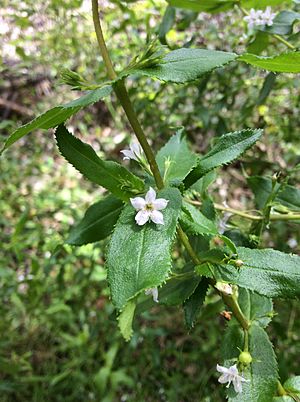Twin-leaf myoporum facts for kids
Quick facts for kids Twin-leaf myoporum |
|
|---|---|
 |
|
| Myoporum oppositifolium at Beedelup Falls in Beedelup National Park | |
| Scientific classification | |
| Genus: |
Myoporum
|
| Species: |
oppositifolium
|
The Twin-leaf Myoporum (scientific name: Myoporum oppositifolium) is a special plant. It belongs to the figwort family, also known as Scrophulariaceae. This plant is easy to spot because its leaves and branches are smooth, not hairy. Its leaves also grow in pairs directly opposite each other, and they have jagged edges like a saw. You can only find this plant in the very southwest part of Western Australia.
What It Looks Like
The Twin-leaf Myoporum is a shrub that stands upright. It usually grows to be about 1–2 metres (3–7 ft) tall. Its branches are smooth and often have small, raised bumps that look like warts.
The leaves also have these small bumps, especially on their underside. They grow in pairs, with each leaf directly across from another. The leaves are shaped like an egg or a narrow spear. They are about 20–50 millimetres (0.8–2 in) long and 8–16 millimetres (0.3–0.6 in) wide. The edges of the leaves are serrated, meaning they have small, sharp teeth all along their length.
The flowers grow in groups of one to four. They appear where the leaves meet the stem, on a small stalk about 6–11 millimetres (0.2–0.4 in) long. Each flower has 5 green or purplish sepals (these are like small leaves that protect the flower bud). It also has 5 petals that are joined together at their bottom to form a tube.
The flower tube is white. It has purple spots on the parts that spread out and on the top of the tube. The tube itself is about 2–3.2 millimetres (0.08–0.1 in) long, and the spreading parts are about 2.5–4 millimetres (0.1–0.2 in) long. Inside the flower, there are 4 stamens (the parts that produce pollen) that stick out a little past the petals.
This plant can flower all year round! After the flowers, it grows small fruits. These fruits are lilac to brown in color and are round, like a small ball. They are about 2.5–5 millimetres (0.1–0.2 in) across. These fruits are called drupes, which means they have a hard pit inside, like a peach or a cherry.
Plant Naming and History
The scientific name Myoporum oppositifolium was first officially described in 1810. This was done by a famous botanist named Robert Brown. He published his description in a book called Prodromus Florae Novae Hollandiae.
The second part of the plant's scientific name, oppositifolium, tells us something important about it. It comes from two Latin words: oppositus, which means "standing opposite," and folium, which means "leaf." This perfectly describes how the leaves grow in pairs directly across from each other on the stem.
Where It Lives
The Twin-leaf Myoporum grows along the coast of Western Australia. You can find it from near Busselton all the way to near Albany. It lives in special areas called the Esperance Plains, Jarrah Forest, and Warren regions.
This plant likes to grow in sandy or loamy soil (a mix of sand, silt, and clay). It is often found near karri trees and along rivers or streams. Sometimes, you can even see it growing on cliffs right by the coast.
Conservation Status
The Western Australian Government Department of Parks and Wildlife has looked at the Twin-leaf Myoporum. They have officially classified it as "not threatened." This means that there are enough of these plants in the wild, and they are not currently in danger of disappearing.

